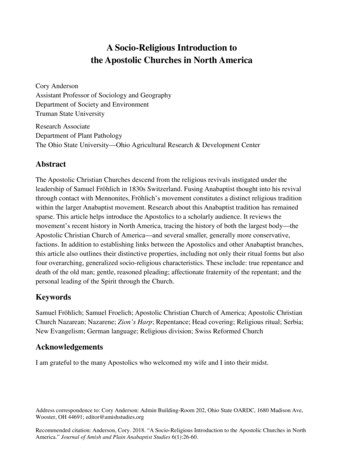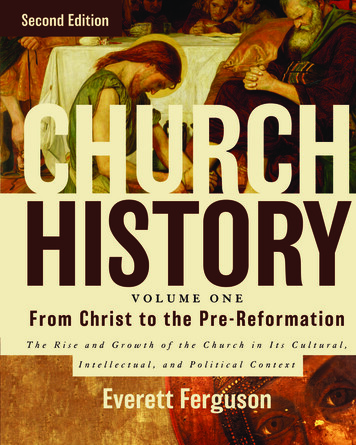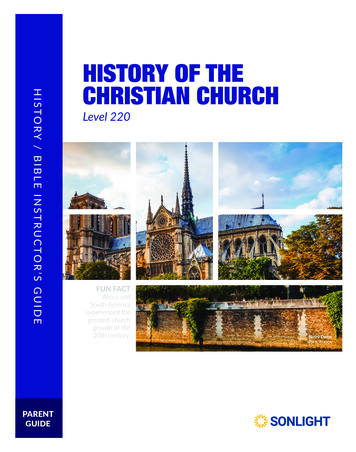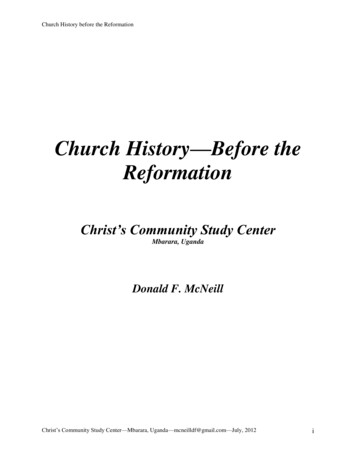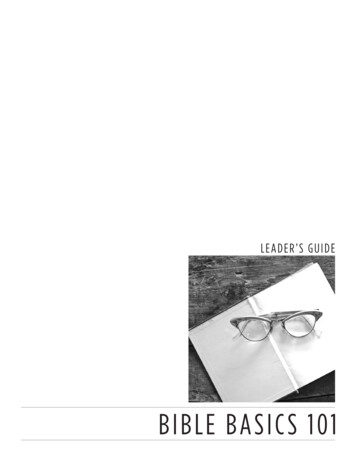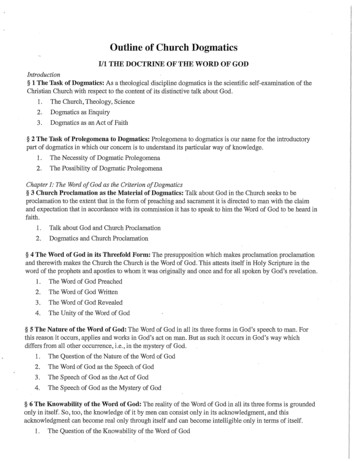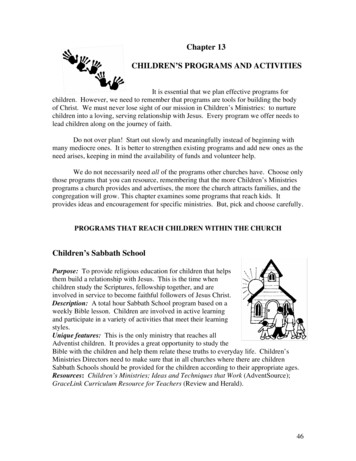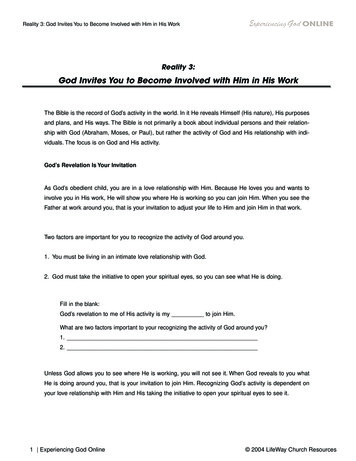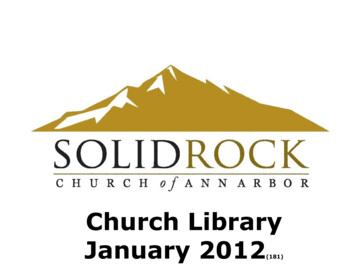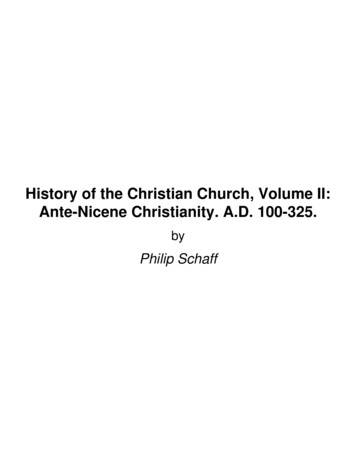
Transcription
History of the Christian Church, Volume II:Ante-Nicene Christianity. A.D. 100-325.byPhilip Schaff
About History of the Christian Church, Volume II: Ante-Nicene Christianity.A.D. 100-325. by Philip SchaffTitle:URL:Author(s):Publisher:First Published:Print Basis:Source:Rights:Date Created:Contributor(s):CCEL Subjects:LC Call no:LC Subjects:History of the Christian Church, Volume II: Ante-Nicene Christianity.A.D. chaff, Philip (1819-1893)Grand Rapids, MI: Christian Classics Ethereal Library1882Third edition, revisedElectronic Bible SocietyPublic Domain2002-11-27whp (Transcriber)Wendy Huang (Markup)All; History;BR145.S3ChristianityHistory
History of the Christian Church, Volume II:Ante-Nicene Christianity. A.D. 100-325.Philip SchaffTable of ContentsAbout This Book. . . . . . . . . . . . . . . . . . . . . . . . . . . . . . . . . . . . . . p. iiTitle Page. . . . . . . . . . . . . . . . . . . . . . . . . . . . . . . . . . . . . . . . . . p. 1Preface to the Third Edition Revised. . . . . . . . . . . . . . . . . . . . . . . . . p. 2Fifth Edition. . . . . . . . . . . . . . . . . . . . . . . . . . . . . . . . . . . . . . . . . p. 3Preface to the Second Edition. . . . . . . . . . . . . . . . . . . . . . . . . . . . . p. 4Second Period: Ante-Nicene Christianity. . . . . . . . . . . . . . . . . . . . . . p. 7Literature on the Ante-Nicene Age. . . . . . . . . . . . . . . . . . . . . . . . . p. 7General Character of Ante-Nicene Christianity. . . . . . . . . . . . . . . . . p. 10Spread of Christianity. . . . . . . . . . . . . . . . . . . . . . . . . . . . . . . . . . p. 13Literature. . . . . . . . . . . . . . . . . . . . . . . . . . . . . . . . . . . . . . . . . p. 13Hindrances and Helps. . . . . . . . . . . . . . . . . . . . . . . . . . . . . . . . p. 14Causes of the Success of Christianity. . . . . . . . . . . . . . . . . . . . . . p. 15Means of Propagation. . . . . . . . . . . . . . . . . . . . . . . . . . . . . . . . p. 17Extent of Christianity in the Roman Empire. . . . . . . . . . . . . . . . . . . p. 18Christianity in Asia. . . . . . . . . . . . . . . . . . . . . . . . . . . . . . . . . . . p. 19Christianity in Egypt. . . . . . . . . . . . . . . . . . . . . . . . . . . . . . . . . . p. 20Christianity in North Africa. . . . . . . . . . . . . . . . . . . . . . . . . . . . . . p. 21Christianity in Europe. . . . . . . . . . . . . . . . . . . . . . . . . . . . . . . . . p. 22Persecution of Christianity and Christian Martyrdom. . . . . . . . . . . . . . p. 24Literature. . . . . . . . . . . . . . . . . . . . . . . . . . . . . . . . . . . . . . . . . p. 24General Survey. . . . . . . . . . . . . . . . . . . . . . . . . . . . . . . . . . . . p. 25Jewish Persecution. . . . . . . . . . . . . . . . . . . . . . . . . . . . . . . . . . p. 27Causes of Roman Persecution. . . . . . . . . . . . . . . . . . . . . . . . . . . p. 29Condition of the Church before the Reign of Trajan. . . . . . . . . . . . . p. 32Trajan. A.D. 98-117--Christianity Forbidden--Martyrdom of Symeon ofJerusalem, and Ignatius of Antioch. . . . . . . . . . . . . . . . . . . . . . . . p. 32Hadrian. a.d. 117-138. . . . . . . . . . . . . . . . . . . . . . . . . . . . . . . . p. 35Antoninus Pius. a.d. 137-161. The Martyrdom of Polycarp. . . . . . . . . p. 36Persecutions under Marcus Aurelius. A.D. 161-180. . . . . . . . . . . . . p. 37Condition of the Church from Septimius Severus to Philip the Arabian.A.D. 193-249. . . . . . . . . . . . . . . . . . . . . . . . . . . . . . . . . . . . . . p. 40Persecutions under Decius, and Valerian. a.d. 249-260. Martyrdom ofCyprian. . . . . . . . . . . . . . . . . . . . . . . . . . . . . . . . . . . . . . . . . . p. 42Temporary Repose. A.D. 260-303. . . . . . . . . . . . . . . . . . . . . . . . p. 43The Diocletian Persecution, a.d. 303-311. . . . . . . . . . . . . . . . . . . . p. 44iii
History of the Christian Church, Volume II:Ante-Nicene Christianity. A.D. 100-325.Philip SchaffThe Edicts of Toleration. a.d. 311-313. . . . . . . . . . . . . . . . . . . . . . p. 48Christian Martyrdom. . . . . . . . . . . . . . . . . . . . . . . . . . . . . . . . . p. 50Rise of the Worship of Martyrs and Relics. . . . . . . . . . . . . . . . . . . p. 55Literary Contest of Christianity with Judaism and Heathenism. . . . . . . p. 56Literature. . . . . . . . . . . . . . . . . . . . . . . . . . . . . . . . . . . . . . . . . p. 56Literary Opposition to Christianity. . . . . . . . . . . . . . . . . . . . . . . . . p. 57Jewish Opposition. Josephus and the Talmud. . . . . . . . . . . . . . . . . p. 58Pagan Opposition. Tacitus and Pliny. . . . . . . . . . . . . . . . . . . . . . . p. 58Direct Assaults. Celsus. . . . . . . . . . . . . . . . . . . . . . . . . . . . . . . p. 59L u c i a n . . . . . . . . . . . . . . . . . . . . . . . . . . . . . . . . . . . . . . . . . . p. 61Neo-Platonism. . . . . . . . . . . . . . . . . . . . . . . . . . . . . . . . . . . . . p. 63Porphyry and Hierocle. . . . . . . . . . . . . . . . . . . . . . . . . . . . . . . . p. 66Summary of the Objections to Christianity. . . . . . . . . . . . . . . . . . . p. 67The Apologetic Literature of Christianity. . . . . . . . . . . . . . . . . . . . . p. 68The Argument against Judaism. . . . . . . . . . . . . . . . . . . . . . . . . . p. 69The Defense against Heathenism. . . . . . . . . . . . . . . . . . . . . . . . . p. 71The Positive Apology. . . . . . . . . . . . . . . . . . . . . . . . . . . . . . . . . p. 74Organization and Discipline of the Church. . . . . . . . . . . . . . . . . . . . p. 77Progress in Consolidation. . . . . . . . . . . . . . . . . . . . . . . . . . . . . . p. 77Clergy and Laity. . . . . . . . . . . . . . . . . . . . . . . . . . . . . . . . . . . . p. 78New Church Officers. . . . . . . . . . . . . . . . . . . . . . . . . . . . . . . . . p. 83Origin of the Episcopate. . . . . . . . . . . . . . . . . . . . . . . . . . . . . . . p. 84Development of the Episcopate. Ignatius. . . . . . . . . . . . . . . . . . . . p. 91Episcopacy at the time of Irenaeus and Tertullian. . . . . . . . . . . . . . p. 93Cyprianic Episcopacy. . . . . . . . . . . . . . . . . . . . . . . . . . . . . . . . . p. 94The Pseudo-Clementine Episcopacy. . . . . . . . . . . . . . . . . . . . . . . p. 95Beginnings of the Metropolitan and Patriarchal System. . . . . . . . . . . p. 96Germs of the Papacy. . . . . . . . . . . . . . . . . . . . . . . . . . . . . . . . . p. 97Chronology of the Popes. . . . . . . . . . . . . . . . . . . . . . . . . . . . . . p. 102List of the Roman Bishops and Roman Emperors during the First ThreeCenturies. . . . . . . . . . . . . . . . . . . . . . . . . . . . . . . . . . . . . . . . p. 104The Catholic Unity. . . . . . . . . . . . . . . . . . . . . . . . . . . . . . . . . . . p. 108Councils. . . . . . . . . . . . . . . . . . . . . . . . . . . . . . . . . . . . . . . . . p. 113The Councils of Elvira, Arles, and Ancyra. . . . . . . . . . . . . . . . . . . . p. 115Collections of Ecclesiastical Law. The Apostolical Constitutions andCanons. . . . . . . . . . . . . . . . . . . . . . . . . . . . . . . . . . . . . . . . . . p. 117Church Discipline. . . . . . . . . . . . . . . . . . . . . . . . . . . . . . . . . . . p. 119Church Schisms. . . . . . . . . . . . . . . . . . . . . . . . . . . . . . . . . . . . p. 123Christian Worship. . . . . . . . . . . . . . . . . . . . . . . . . . . . . . . . . . . . p. 126Places of Common Worship. . . . . . . . . . . . . . . . . . . . . . . . . . . . p. 126iv
History of the Christian Church, Volume II:Ante-Nicene Christianity. A.D. 100-325.Philip SchaffThe Lord's Day. . . . . . . . . . . . . . . . . . . . . . .The Christian Passover. (Easter). . . . . . . . . . .The Paschal Controversies. . . . . . . . . . . . . . .Pentecost. . . . . . . . . . . . . . . . . . . . . . . . . .The Epiphan. . . . . . . . . . . . . . . . . . . . . . . .The Order of Public Worship. . . . . . . . . . . . . .Parts of Worship. . . . . . . . . . . . . . . . . . . . . .Division of Divine Service. The Disciplina Arcani.Celebration of the Eucharist. . . . . . . . . . . . . .The Doctrine of the Eucharist. . . . . . . . . . . . .The Celebration of Baptism. . . . . . . . . . . . . . .The Doctrine of Baptism. . . . . . . . . . . . . . . . .Catechetical Instruction and Confirmation. . . . .Infant Baptism. . . . . . . . . . . . . . . . . . . . . . .Heretical Baptism. . . . . . . . . . . . . . . . . . . . .Christian Art. . . . . . . . . . . . . . . . . . . . . . . . . .Literature. . . . . . . . . . . . . . . . . . . . . . . . . . .Origin of Christian Art. . . . . . . . . . . . . . . . . . .The Cross and the Crucifix. . . . . . . . . . . . . . .Other Christian Symbols. . . . . . . . . . . . . . . . .Historical and Allegorical Picture. . . . . . . . . . .Allegorical Representations of Christ. . . . . . . . .Pictures of the Virgin Mary. . . . . . . . . . . . . . .The Church in the Catacombs. . . . . . . . . . . . . .Literature. . . . . . . . . . . . . . . . . . . . . . . . . . .Origin and History of the Catacomb. . . . . . . . .Description of the Catacombs. . . . . . . . . . . . .Pictures and Sculptures. . . . . . . . . . . . . . . . .Epitaphs. . . . . . . . . . . . . . . . . . . . . . . . . . .Lessons of the Catacombs. . . . . . . . . . . . . . .Christian Life in Contrast with Pagan Corruption. .Literature. . . . . . . . . . . . . . . . . . . . . . . . . . .Moral Corruption of the Roman Empire. . . . . . .Stoic Morality. . . . . . . . . . . . . . . . . . . . . . . .Epictetus. . . . . . . . . . . . . . . . . . . . . . . . . . .Marcus Aurelius. . . . . . . . . . . . . . . . . . . . . .Plutarch. . . . . . . . . . . . . . . . . . . . . . . . . . .Christian Morality. . . . . . . . . . . . . . . . . . . . .The Church and Public Amusements. . . . . . . .Secular Callings and Civil Duties. . . . . . . . . . .v.p. 128p. 131p. 133p. 140p. 141p. 142p. 143p. 150p. 152p. 155p. 159p. 162p. 164p. 165p. 168p. 170p. 170p. 171p. 172p. 175p. 176p. 177p. 180p. 182p. 182p. 184p. 188p. 190p. 191p. 195p. 198p. 198p. 198p. 202p. 204p. 206p. 209p. 211p. 214p. 217
History of the Christian Church, Volume II:Ante-Nicene Christianity. A.D. 100-325.Philip SchaffThe Church and Slavery. . . . . . . . . . . . . . . . . . . . . . . . . . . . . . . p. 219The Heathen Family. . . . . . . . . . . . . . . . . . . . . . . . . . . . . . . . . p. 223The Christian Family. . . . . . . . . . . . . . . . . . . . . . . . . . . . . . . . . p. 227Brotherly Love, and Love for Enemies. . . . . . . . . . . . . . . . . . . . . . p. 232Prayer and Fasting. . . . . . . . . . . . . . . . . . . . . . . . . . . . . . . . . . p. 236Treatment of the Dea. . . . . . . . . . . . . . . . . . . . . . . . . . . . . . . . . p. 238Summary of Moral Reforms. . . . . . . . . . . . . . . . . . . . . . . . . . . . . p. 241Ascetic Tendencies. . . . . . . . . . . . . . . . . . . . . . . . . . . . . . . . . . . p. 242Ascetic Virtue and Piety. . . . . . . . . . . . . . . . . . . . . . . . . . . . . . . p. 242Heretical and Catholic Asceticism. . . . . . . . . . . . . . . . . . . . . . . . . p. 245Voluntary Poverty. . . . . . . . . . . . . . . . . . . . . . . . . . . . . . . . . . . p. 247Voluntary Celibacy. . . . . . . . . . . . . . . . . . . . . . . . . . . . . . . . . . p. 248Celibacy of the Clergy. . . . . . . . . . . . . . . . . . . . . . . . . . . . . . . . p. 252Montanism. . . . . . . . . . . . . . . . . . . . . . . . . . . . . . . . . . . . . . . . . p. 258Literature. . . . . . . . . . . . . . . . . . . . . . . . . . . . . . . . . . . . . . . . . p. 258External History of Montanism. . . . . . . . . . . . . . . . . . . . . . . . . . . p. 259Character and Tenets of Montanism. . . . . . . . . . . . . . . . . . . . . . . p. 262The Heresies of the Ante-Nicene Age. . . . . . . . . . . . . . . . . . . . . . . p. 265Judaism and Heathenism within the Church. . . . . . . . . . . . . . . . . . p. 265Nazarenes and Ebionites (Elkesaites, Mandoeans). . . . . . . . . . . . . p. 267The Pseudo-Clementine Ebionism. . . . . . . . . . . . . . . . . . . . . . . . p. 269Gnosticism. The Literature. . . . . . . . . . . . . . . . . . . . . . . . . . . . . p. 274Meaning, Origin and Character of Gnosticism. . . . . . . . . . . . . . . . . p. 276The System of Gnosticism. Its Theology. . . . . . . . . . . . . . . . . . . . p. 279Ethics of Gnosticism. . . . . . . . . . . . . . . . . . . . . . . . . . . . . . . . . p. 283Cultus and Organization. . . . . . . . . . . . . . . . . . . . . . . . . . . . . . . p. 284Schools of Gnosticism. . . . . . . . . . . . . . . . . . . . . . . . . . . . . . . . p. 284Simon Magus and the Simonians. . . . . . . . . . . . . . . . . . . . . . . . . p. 285The Nicolaitans. . . . . . . . . . . . . . . . . . . . . . . . . . . . . . . . . . . . . p. 287Cerinthus. . . . . . . . . . . . . . . . . . . . . . . . . . . . . . . . . . . . . . . . p. 288Basilides. . . . . . . . . . . . . . . . . . . . . . . . . . . . . . . . . . . . . . . . . p. 289Valentinus. . . . . . . . . . . . . . . . . . . . . . . . . . . . . . . . . . . . . . . . p. 292The School of Valentinus. Heracleon, Ptolemy, Marcos, Bardesanes,Harmonius. . . . . . . . . . . . . . . . . . . . . . . . . . . . . . . . . . . . . . . . p. 296Marcion and his School. . . . . . . . . . . . . . . . . . . . . . . . . . . . . . . p. 299The Ophites. The Sethites. The Peratae. The Cainites. . . . . . . . . . . p. 302Saturninus (Satornilos). . . . . . . . . . . . . . . . . . . . . . . . . . . . . . . . p. 304Carpocrates. . . . . . . . . . . . . . . . . . . . . . . . . . . . . . . . . . . . . . . p. 304Tatian and the Encratites. . . . . . . . . . . . . . . . . . . . . . . . . . . . . . p. 305Justin the Gnostic. . . . . . . . . . . . . . . . . . . . . . . . . . . . . . . . . . . p. 307vi
History of the Christian Church, Volume II:Ante-Nicene Christianity. A.D. 100-325.Philip SchaffHermogenes. . . . . . . . . . . . . . . . . . . . . . . . . . . . . . . . . . . . . . p. 307Other Gnostic Sects. . . . . . . . . . . . . . . . . . . . . . . . . . . . . . . . . p. 308Mani and the Manichaeans. . . . . . . . . . . . . . . . . . . . . . . . . . . . . p. 308The Manichaean System. . . . . . . . . . . . . . . . . . . . . . . . . . . . . . p. 312The Development of Catholic Theology in Conflict with Heresy. . . . . . . p. 314Catholic Orthodoxy. . . . . . . . . . . . . . . . . . . . . . . . . . . . . . . . . . p. 314The Holy Scriptures and the Canon. . . . . . . . . . . . . . . . . . . . . . . p. 319Catholic Tradition. . . . . . . . . . . . . . . . . . . . . . . . . . . . . . . . . . . p. 325The Rule of Faith and the Apostles' Creed. . . . . . . . . . . . . . . . . . . p. 327Variations of the Apostles' Creed. . . . . . . . . . . . . . . . . . . . . . . . . p. 330God and the Creation. . . . . . . . . . . . . . . . . . . . . . . . . . . . . . . . . p. 336Man and the Fall. . . . . . . . . . . . . . . . . . . . . . . . . . . . . . . . . . . . p. 338hrist and the Incarnation. . . . . . . . . . . . . . . . . . . . . . . . . . . . . . . p. 339The Divinity of Christ. . . . . . . . . . . . . . . . . . . . . . . . . . . . . . . . . p. 342The Humanity of Christ. . . . . . . . . . . . . . . . . . . . . . . . . . . . . . . . p. 347The Relation of the Divine and the Human in Christ. . . . . . . . . . . . . p. 349The Holy Spirit. . . . . . . . . . . . . . . . . . . . . . . . . . . . . . . . . . . . . p. 349The Holy Trinity. . . . . . . . . . . . . . . . . . . . . . . . . . . . . . . . . . . . p. 352Antitrinitarians. First Class: The Alogi, Theodotus, Artemon, Paul ofSamosata. . . . . . . . . . . . . . . . . . . . . . . . . . . . . . . . . . . . . . . . p. 356Second Class of Antitrinitarians: Praxeas, Noëtus, Callistus,Berryllus. . . . . . . . . . . . . . . . . . . . . . . . . . . . . . . . . . . . . . . . . p. 359Sabellianism. . . . . . . . . . . . . . . . . . . . . . . . . . . . . . . . . . . . . . p. 361Redemption. . . . . . . . . . . . . . . . . . . . . . . . . . . . . . . . . . . . . . . p. 363Other Doctrines. . . . . . . . . . . . . . . . . . . . . . . . . . . . . . . . . . . . p. 366Eschatology. Immortality and Resurrection. . . . . . . . . . . . . . . . . . . p. 366Between Death and Resurrection. . . . . . . . . . . . . . . . . . . . . . . . . p. 372After Judgment. Future Punishment. . . . . . . . . . . . . . . . . . . . . . . p. 376Chiliasm. . . . . . . . . . . . . . . . . . . . . . . . . . . . . . . . . . . . . . . . . p. 380Ecclesiastical Literature of the Ante-Nicene Age, and Biographical Sketchesof the Church-Fathers. . . . . . . . . . . . . . . . . . . . . . . . . . . . . . . . . p. 385Literature. . . . . . . . . . . . . . . . . . . . . . . . . . . . . . . . . . . . . . . . . p. 385A General Estimate of the Fathers. . . . . . . . . . . . . . . . . . . . . . . . p. 388The Apostolic Fathers. . . . . . . . . . . . . . . . . . . . . . . . . . . . . . . . p. 391Clement of Rome. . . . . . . . . . . . . . . . . . . . . . . . . . . . . . . . . . . p. 394The Pseudo-Clementine Works. . . . . . . . . . . . . . . . . . . . . . . . . . p. 401Ignatius of Antioch. . . . . . . . . . . . . . . . . . . . . . . . . . . . . . . . . . . p. 403The Ignatian Controversy. . . . . . . . . . . . . . . . . . . . . . . . . . . . . . p. 409Polycarp of Smyrna. . . . . . . . . . . . . . . . . . . . . . . . . . . . . . . . . . p. 412Barnabas. . . . . . . . . . . . . . . . . . . . . . . . . . . . . . . . . . . . . . . . p. 416vii
History of the Christian Church, Volume II:Ante-Nicene Christianity. A.D. 100-325.Philip SchaffHermas. . . . . . . . . . . . . . . . . . . . . . .Papias. . . . . . . . . . . . . . . . . . . . . . .The Epistle to Diognetus. . . . . . . . . . . .Sixtus of Rome. . . . . . . . . . . . . . . . . .The Apologists. Quadratus and Aristides.Justin the Philosopher and Martyr. . . . . .The Other Greek Apologists. Tatian. . . .Athenagoras. . . . . . . . . . . . . . . . . . .Theophilus of Antioch. . . . . . . . . . . . .Melito of Sardis. . . . . . . . . . . . . . . . . .Apolinarius of Hierapolis. Miltiades. . . . .Hermias. . . . . . . . . . . . . . . . . . . . . .Hegesippus. . . . . . . . . . . . . . . . . . . .Dionysius of Corinth. . . . . . . . . . . . . .Irenaeu. . . . . . . . . . . . . . . . . . . . . . .Hippolytus. . . . . . . . . . . . . . . . . . . . .Caius of Rome. . . . . . . . . . . . . . . . . .The Alexandrian School of Theology. . . .Clement of Alexandria. . . . . . . . . . . . .Origen. . . . . . . . . . . . . . . . . . . . . . .The Works of Origen. . . . . . . . . . . . . .Gregory Thaumaturgus. . . . . . . . . . . .Dionysius the Great. . . . . . . . . . . . . . .Julius Africanus. . . . . . . . . . . . . . . . .Minor Divines of the Greek Church. . . . .Opponents of Origen. Methodius. . . . . .Lucian of Antioch. . . . . . . . . . . . . . . .The Antiochian School. . . . . . . . . . . . .Tertullian and the African School. . . . . .The Writings of Tertullian. . . . . . . . . . .Minucius Felix. . . . . . . . . . . . . . . . . .Cyprian. . . . . . . . . . . . . . . . . . . . . . .Novatian. . . . . . . . . . . . . . . . . . . . . .Commodian. . . . . . . . . . . . . . . . . . . .Arnobius. . . . . . . . . . . . . . . . . . . . . .Victorinus of Petau. . . . . . . . . . . . . . .Eusebius, Lactantius, Hosius. . . . . . . . .Indexes. . . . . . . . . . . . . . . . . . . . . . . . .Subject Index. . . . . . . . . . . . . . . . . . . .Index of Scripture References. . . . . . . . .viii.p. 421p. 430p. 434p. 437p. 440p. 441p. 451p. 454p. 455p. 457p. 459p. 460p. 461p. 463p. 463p. 470p. 482p. 483p. 486p. 488p. 493p. 495p. 498p. 499p. 501p. 503p. 505p. 507p. 508p. 515p. 518p. 523p. 528p. 530p. 532p. 535p. 537p. 539p. 539p. 540
History of the Christian Church, Volume II:Ante-Nicene Christianity. A.D. 100-325.Index of Names. . . . . . . . .Greek Words and Phrases. .Hebrew Words and Phrases.Latin Words and Phrases. . .German Words and Phrases.French Words and Phrases. .Philip Schaff.ix.p. 543p. 548p. 574p. 575p. 575p. 593
History of the Christian Church, Volume II:Ante-Nicene Christianity. A.D. 100-325.Philip Schaffx
History of the Christian Church, Volume II: Ante-NiceneChristianity. A.D. 100-325.Philip SchaffHISTORYof theCHRISTIAN CHURCH1byPHILIP SCHAFFChristianus sum.Christiani nihil a me alienum putoVOLUME IIANTE-NICENE CHRISTIAINITYa.d. 100–325.1Schaff, Philip, History of the Christian Church, (Oak Harbor, WA: Logos Research Systems, Inc.) 1997. This material has beencarefully compared, corrected, and emended (according to the 1910 edition of Charles Scribner's Sons) by The Electronic Bible Society,Dallas, TX, 1998.
History of the Christian Church, Volume II: Ante-NiceneChristianity. A.D. 100-325.Philip SchaffPREFACE TO THE THIRD EDITION REVISEDA few months after the appearance of the revised edition of this volume, Dr. Bryennios, thelearned Metropolitan of Nicomedia, surprised the world by the publication of the now famousDidache, which he had discovered in the Jerusalem Monastery of the Most Holy Sepulchre atConstantinople. This led me, in justice to myself and to my readers, to write an independentsupplement under the title: The Oldest Church Manual, called the Teaching of the Twelve Apostles,etc., which is now passing through the press.At the same time I have taken advantage of a new issue of this History, without increasingthe size and the price, to make in the plates all the necessary references to the Didache where itsheds new light on the post-apostolic age (especially on pages 140, 184, 185, 202, 226, 236, 239,241, 247, 249, 379, 640).I have also brought the literature up to date, and corrected a few printing errors, so that thisissue may be called a revised edition. A learned and fastidious German critic and professionalchurch historian has pronounced this work to be far in advance of any German work in the fullnessof its digest of the discoveries and researches of the last thirty years. ("Theolog. Literatur-Zeitung,"for March 22, 1884.) But the Bryennios discovery, and the extensive literature which it has calledforth, remind me of the imperfect character of historical books in an age of such rapid progress asours.The Author.New York, April 22, 1885.2
History of the Christian Church, Volume II: Ante-NiceneChristianity. A.D. 100-325.Philip SchaffFIFTH EDITIONThe fourth edition (1886) was a reprint of the third, with a few slight improvements. In thisfifth edition I have made numerous additions to the literature, and adapted the text throughout tothe present stage of research, which continues to be very active and fruitful in the Ante-Niceneperiod.Several topics connected with the catechetical instruction, organization, and ritual (baptismand eucharist) of the early Church are more fully treated in my supplementary monograph, TheTeaching of the Twelve Apostles, or The Oldest Church Manual, which first appeared in June, 1885,and in a third edition, revised and enlarged, January, 1889, (325 pages).P. S.New York, July, 1889.3
History of the Christian Church, Volume II: Ante-NiceneChristianity. A.D. 100-325.Philip SchaffPREFACE TO THE SECOND EDITIONThis second volume contains the history of Christianity from the end of the Apostolic age tothe beginning of the Nicene.The first edict of Toleration, A. D. 311, made an end of persecution; the second Edict ofToleration, 311 (there is no third), prepared the way for legal recognition and protection; the NiceneCouncil, 325, marks the solemn inauguration of the imperial state-church. Constantine, like Eusebius,the theologian, and Hosius, the statesman, of his reign, belongs to both periods and must beconsidered in both, though more fully in the next.We live in an age of discovery and research, similar to that which preceded the Reformation.The beginnings of Christianity are now absorbing the attention of scholars.During the present generation early church history has been vastly enriched by new sourcesof information, and almost revolutionized by independent criticism. Among the recent literarydiscoveries and publications the following deserve special mention:The Syriac Ignatius (by Cureton 1845 and 1849), which opened a new chapter in the Ignatiancontroversy so closely connected with the rise of Episcopacy and Catholicism; the Philosophumenaof Hippolytus (by Miller 1851, and by Duncker and Schneidewin, 1859), which have shed a floodof light on the ancient heresies and systems of thought, as well as on the doctrinal and disciplinarycommotions in the Roman church in the early part of third century; the Tenth Book of ThePseudo-Clementine Homilies (by Dressel, 1853), which supplements our knowledge of a curioustype of distorted Christianity in the post-apostolic age, and furnishes, by an undoubted quotation,a valuable contribution to the solution of the Johannean problem; the Greek Hermas from Mt. Athos(the Codex Lipsiensis, published by Anger and Tischendorf, 1856); a new and complete GreekMS. of the First Epistle of the Roman Clement with several important new chapters and theoldestwritten Christian prayer (about one tenth of the whole), found in a Convent Library atConstantinople (by Bryennios, 1875); and in the same Codex the Second (so called) Epistle ofClement, or post-Clementine Homily rather, in its complete form (20 chs. instead of 12), giving usthe first post-apostolic sermon, besides a new Greek text of the Epistle of Barnabus; a Syriac Versionof Clement in the library of Jules Mohl, now at Cambridge (1876); fragments of Tatian’s Diatessaronwith Ephraem’s Commentary on it, in an Armenian version (Latin by Mösinger 1878); fragmentsof the apologies of Melito (1858), and Aristides (1878); the complete Greek text of the Acts ofThomas (by Max Bonnet, 1883); and the crowning discovery of all, the Codex Sinaiticus, the onlycomplete uncial MS. of the Greek Testament, together with the Greek Barnabus and the GreekHermas (by Tischendorf, 1862), which, with the facsimile edition of the Vatican Codex (1868–1881,6 vols.), marks an epoch in the science of textual criticism of the Greek Testament and of thosetwo Apostolic Fathers, and establishes the fact of the ecclesiastical use of all our canonical booksin the age of Eusebius.In view of these discoveries we would not be surprised if the Exposition of the Lord’sOracles by Papias, which was still in existence at Nismes in 1215, the Memorials of Hegesippus,and the whole Greek original of Irenaeus, which were recorded by a librarian as extant in thesixteenth century, should turn up in some old convent.In connection with these fresh sources there has been a corresponding activity on the partof scholars. The Germans have done and are doing an astonishing amount of Quellenforschung andQuellenkritik in numerous monographs and periodicals, and have given us the newest and best criticaleditions of the Apostolic Fathers and Apologists. The English with their strong common sense,4
History of the Christian Church, Volume II: Ante-NiceneChristianity. A.D. 100-325.Philip Schaffjudicial calmness, and conservative tact are fast wheeling into the line of progress, as is evidentfrom the collective works on Christian Antiquities, and the Christian Biography, and from Bp.Lightfoot’s Clementine Epistles, which are soon to be followed by his edition of the IgnatianEpistles. To the brilliant French genius and learning of Mr. Renan we owe a graphic picture of thesecular surroundings of early Christianity down to the time of Marcus Aurelius, with sharp glancesinto the literature and life of the church. His Historie des Origines du Christianisme, now completed in sevenvolumes, after twenty year’s labor, is well worthy to rank with Gibbon’s immortal work. The Riseand Triumph of Christianity is a grander theme than the contemporary Decline and Fall of theRoman Empire, but no historian can do justice to it without faith in the divine character and missionof that peaceful Conqueror of immortal souls, whose kingdom shall have no end.The importance of these literary discoveries and investigations should not blind us to thealmost equally important monumental discoveries and researches of Cavalier de Rossi, Garrucci,and other Italian scholars who have illuminated the subterranean mysteries of the church of Romeand of Christian art. Neander, Gieseler, and Baur, the greatest church historians of the nineteenthcentury, are as silent about the catacombs as Mosheim and Gibbon were in the eighteenth. But whocould now write a history of the first three centuries without rec
History of the Christian Church, Volume II: Ante-Nicene Christianity. A.D. 100-325. by Philip Schaff. This document has been generated from XSL (Extensible Stylesheet Language) source w
